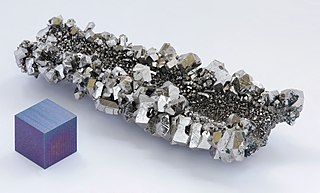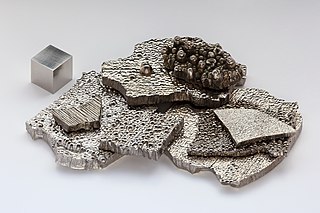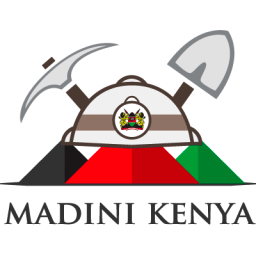Related Research Articles

Niobium, also known as columbium, is a chemical element with the symbol Nb and atomic number 41. Niobium is a light grey, crystalline, and ductile transition metal. Pure niobium has a Mohs hardness rating similar to that of pure titanium, and it has similar ductility to iron. Niobium oxidizes in the earth's atmosphere very slowly, hence its application in jewelry as a hypoallergenic alternative to nickel. Niobium is often found in the minerals pyrochlore and columbite, hence the former name "columbium". Its name comes from Greek mythology, specifically Niobe, who was the daughter of Tantalus, the namesake of tantalum. The name reflects the great similarity between the two elements in their physical and chemical properties, making them difficult to distinguish.

Ore is natural rock or sediment that contains one or more valuable minerals, typically containing metals, that can be mined, treated and sold at a profit. Ore is extracted from the earth through mining and treated or refined, often via smelting, to extract the valuable metals or minerals. The grade of ore refers to the concentration of the desired material it contains. The value of the metals or minerals a rock contains must be weighed against the cost of extraction to determine whether it is of sufficiently high grade to be worth mining, and is therefore considered an ore.

Tantalum is a chemical element with the symbol Ta and atomic number 73. Previously known as tantalium, it is named after Tantalus, a villain from Greek mythology. Tantalum is a rare, hard, blue-gray, lustrous transition metal that is highly corrosion-resistant. It is part of the refractory metals group, which are widely used as minor components in alloys. The chemical inertness of tantalum makes it a valuable substance for laboratory equipment, and as a substitute for platinum. Its main use today is in tantalum capacitors in electronic equipment such as mobile phones, DVD players, video game systems and computers. Tantalum, always together with the chemically similar niobium, occurs in the mineral groups tantalite, columbite and coltan. Tantalum is considered a technology-critical element.

Coltan is a dull black metallic ore from which the elements niobium and tantalum are extracted. The niobium-dominant mineral in coltan is columbite, and the tantalum-dominant mineral is the tantalite.

Columbite, also called niobite, niobite-tantalite and columbate [(Fe, Mn)Nb
2O
6], is a black mineral group that is an ore of niobium. It has a submetallic luster and a high density and is a niobate of iron and manganese. This mineral group was first found in Haddam, Connecticut, in the United States. It forms a series with the tantalum-dominant analogue ferrotantalite and one with the manganese-dominant analogue manganocolumbite. The iron-rich member of the columbite group is ferrocolumbite. Some tin and tungsten may be present in the mineral. Yttrocolumbite is the yttrium-rich columbite with the formula (Y,U,Fe)(Nb,Ta)O
4. It is a radioactive mineral found in Mozambique.

The mineral group tantalite [(Fe, Mn)Ta2O6] is the primary source of the chemical element tantalum. It is chemically similar to columbite, and the two are often grouped together as a semi-singular mineral called coltan or "columbite-tantalite" in many mineral guides. However, tantalite has a much greater specific gravity than columbite (8.0+ compared to columbite's 5.2). Iron-rich tantalite is the mineral tantalite-(Fe) or ferrotantalite and manganese-rich is tantalite-(Mn) or manganotantalite.

Heinrich Rose was a German mineralogist and analytical chemist. He was the brother of the mineralogist Gustav Rose and a son of Valentin Rose. Rose's early works on phosphorescence were noted in the Quarterly Journal of Science in 1821, and on the strength of these works, he was elected privatdozent at the University of Berlin from 1822, then Professor from 1832.

The mining industry of the Democratic Republic of the Congo plays a significant role in the world's supply of cobalt, copper, diamond, tantalum, tin, gold and produces over 70% of globally produced cobalt. It is the Democratic Republic of the Congo's largest source of export income.

Conflict resources are natural resources extracted in a conflict zone and sold to perpetuate the fighting. There is both statistical and anecdotal evidence that belligerent accessibility to precious commodities can prolong conflicts. The most prominent contemporary example has been the eastern provinces of the Democratic Republic of the Congo (DRC), where various armies, rebel groups, and outside actors have profited from mining while contributing to violence and exploitation during wars in the region.

Mining is important to the economy of Ethiopia as a diversification from agriculture. Currently, mining comprises only 1% of GDP. Gold, gemstones, and industrial minerals are important commodities for the country's export-oriented growth strategy. Tantalum mining has also been profitable. It was reported that in the late 1980s, the mineral industry lacked importance given that it contributed less than 0.2 percent of Ethiopia's GDP. Mining for gold is a key development sector in the country. Gold export, which was just US$5 million in 2001, has recorded a large increase to US$602 million in 2012.
The mining of minerals in Nigeria accounts for only 0.3% of its gross domestic product, due to the influence of its vast oil resources. The domestic mining industry is underdeveloped, leading to Nigeria having to import minerals that it could produce domestically, such as salt or iron ore. Rights to ownership of mineral resources is held by the Federal government of Nigeria, which grants titles to organizations to explore, mine, and sell mineral resources. Organized mining began in 1903 when the Mineral Survey of the Northern Protectorates was created by the British colonial government. A year later, the Mineral Survey of the Southern Protectorates was founded. By the 1940s, Nigeria was a major producer of tin, columbite, and coal. The discovery of oil in 1956 hurt the mineral extraction industries, as government and industry both began to focus on this new resource. The Nigerian Civil War in the late 1960s led many expatriate mining experts to leave the country. Mining regulation is handled by the Ministry of Solid Minerals Development, which oversees the management of all mineral resources. Mining law is codified in the Federal Minerals and Mining Act of 1999. Historically, Nigeria's mining industry was monopolized by state-owned public corporations. This led to a decline in productivity in almost all mineral industries. The Obasanjo administration began a process of selling off government-owned corporations to private investors in 1999. The Nigerian Mining Industry has picked up since the "Economic Diversification Agenda", from Oil & Gas, to Agriculture, Mining, etc., began in the country.
The regulation of mining in Equatorial Guinea is handled by the Ministry of Mines, Industry, and Energy, which oversees activities in the mining and petroleum industries.
The mineral industry of Russia is one of the world's leading mineral industries and accounts for a large percentage of the Commonwealth of Independent States' production of a range of mineral products, including metals, industrial minerals, and mineral fuels. In 2005, Russia ranked among the leading world producers or was a significant producer of a vast range of mineral commodities, including aluminum, arsenic, cement, copper, magnesium compounds and metals, nitrogen, palladium, silicon, nickel and vanadium.
The mineral industry of Mozambique plays a significant role in the world's production of aluminium, beryllium, and tantalum. In 2006, Mozambique's share of the world's tantalum mine output amounted to 6%; beryllium, 5%; and aluminium, 2%. Other domestically significant mineral processing operations included cement and natural gas.

The following outline is provided as an overview of and topical guide to mining:

Tanco Mine or Bernic Lake mine is an underground caesium and tantalum mine, owned and operated by Sinomine on the north west shore of Bernic Lake, Manitoba, Canada. The mine has the largest known deposit of pollucite and is also the world's largest producer of caesium.

Coltan is the colloquial name for the mineral columbite-tantalum ("col-tan"); it is sometimes incorrectly used as shorthand for tantalite, a metallic ore from which the very similar elements niobium, also known as columbium, and tantalum are extracted. In the early 21st century coltan mining was associated with human rights violations such as child labour, systematic exploitation of the population by governments or militant groups, exposure to toxic chemicals and other hazards as a result of lax environmental protection, and general safety laws and regulations.

Ixiolite is an accessory oxide mineral found in granitic pegmatites. It is an oxide with the general chemical formula (Ta,Nb,Sn,Mn,Fe)
4O
8 or (Ta,Mn,Nb)O
2.
The geology of Burundi consists largely of metamorphic rocks of Proterozoic age with inliers of basement rocks of Archaean age. The former are metasediments of the Burundian and Malagaarasian Supergroups which are of Meso- and Neoproterozoic age, respectively. Granites intrude the rocks from the Burundian Supergroup along a 350 km zone of mafic and ultramafic intrusions. Just like Tanzania, the Malagarasian Supergroup has Neoproterozoic rocks. The top of this group contains the Kibago Group, which consists of sandstones, quartzites, shales, and a basal conglomerate.

The Ministry of Mining of the Republic of Kenya is a Kenyan government ministry that oversees the Mineral sector in the country.
References
- ↑ USGS Report 2005
- ↑ International Monetary Fund report (2006), p. 80
- 1 2 3 Riragonya, Damien, Director General of Geology and Mines, Burundi Ministry of Energy and Mines, June 26, 2006.
- ↑ International Monetary Fund report, 2006, p. 90